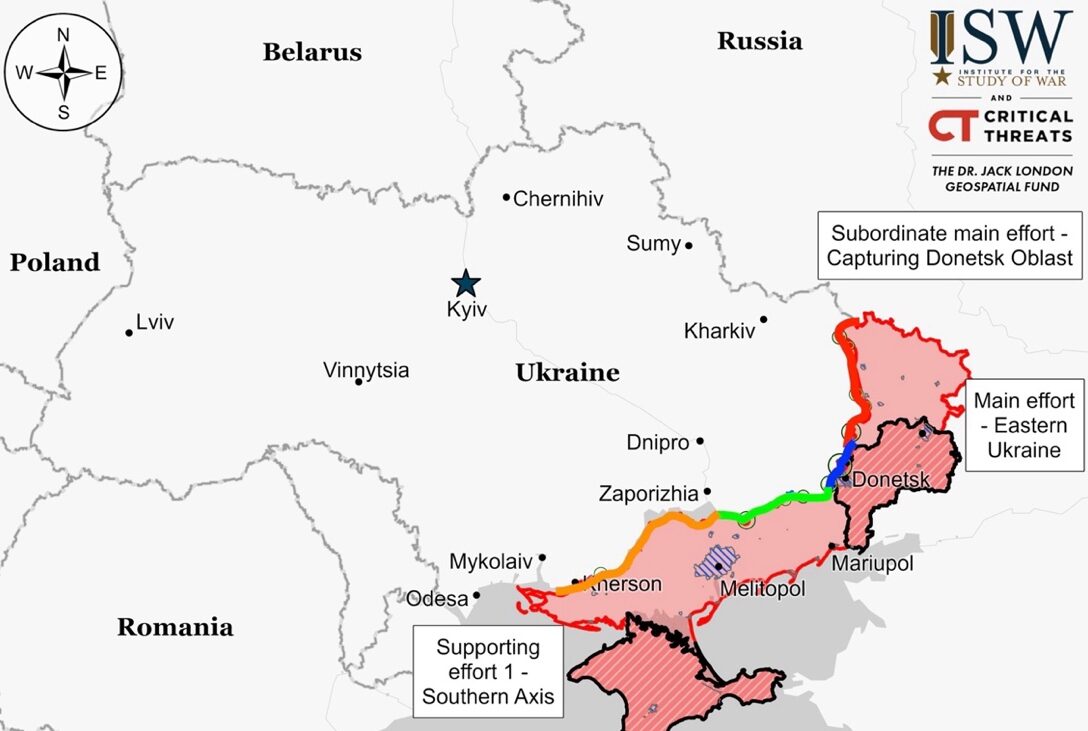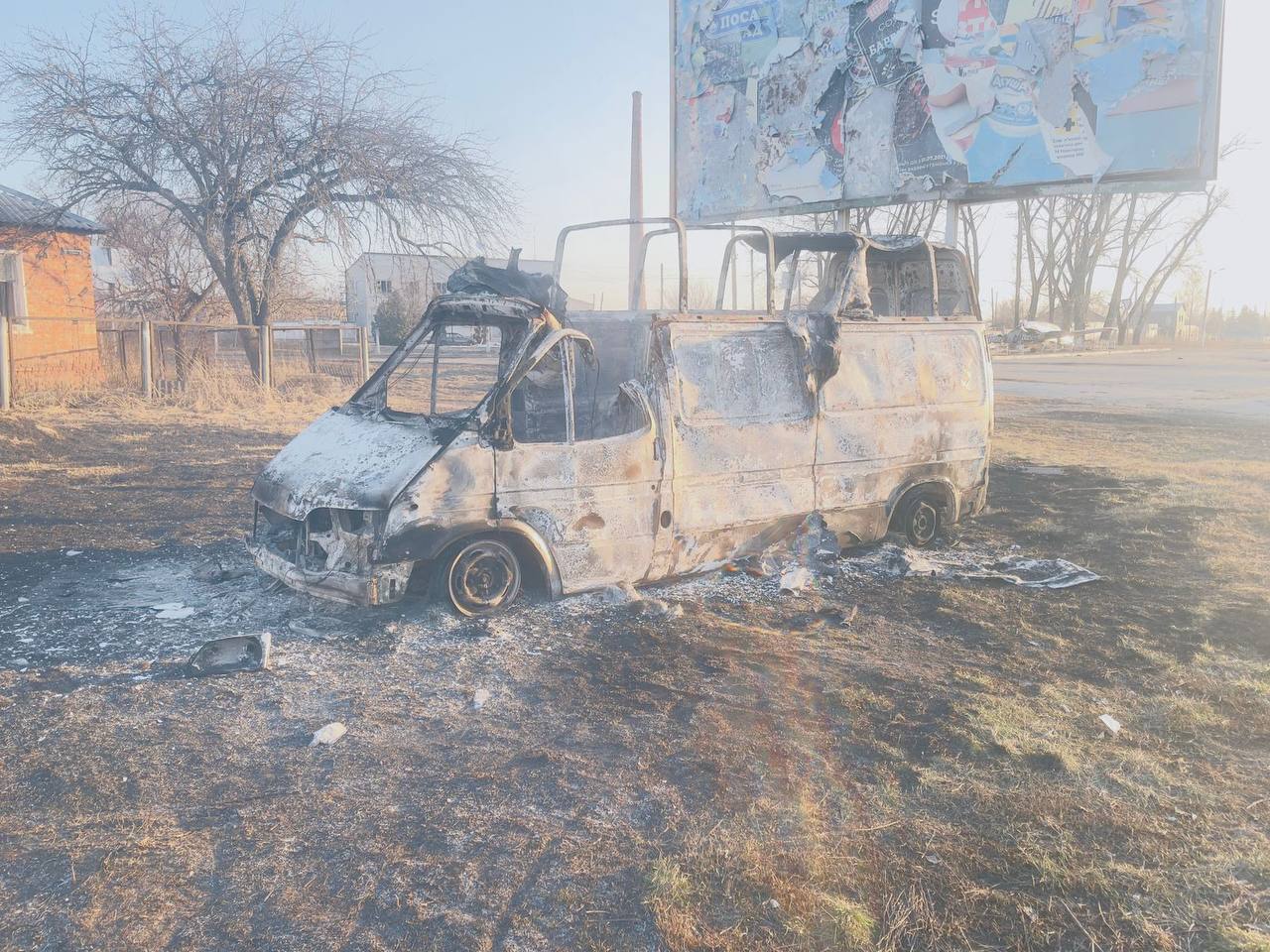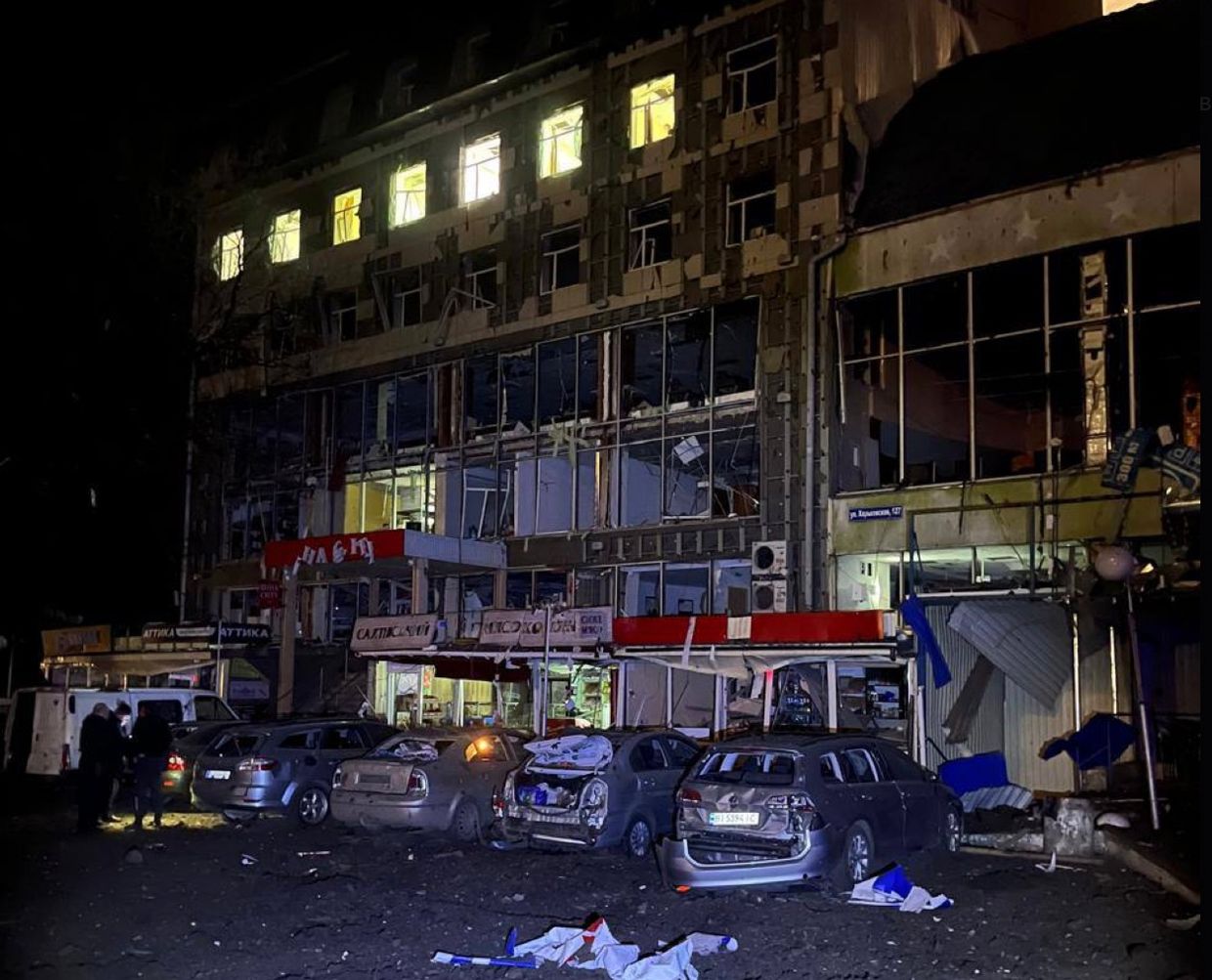Summary of the day: Troop advances by Russian forces near Avdiivka marked today’s developments, despite Ukrainian President Volodymyr Zelensky’s stance against a ceasefire, fearing it would allow Russia to regroup for future offensives. Ukrainian efforts to bolster their armed forces with female recruits continued, expanding their mobilization base. Meanwhile, international pressure mounted on Russia, with the IAEA calling for its withdrawal from the Zaporizhzhia Nuclear Power Plant, and reports surfaced of significant casualties among Russian soldiers in Ukraine, casting a shadow over Moscow’s aims to portray President Putin’s popularity as overwhelmingly high.
What Can I Do To Help Ukraine? This is a question I receive all the time. We at Transform Ukraine are building longer-term housing for internally displaced Ukrainians. Visit Rebuild Ukraine for how you can assist in housing a Ukrainian family displaced by the war.
Situation On The Ground And Air
Russian forces displayed improved tactical capabilities and utilized limited tactical surprise in their recent efforts to seize Avdiivka, as observed by Ukrainian military observer Kostyantyn Mashovets. Mashovets noted a tactical shift in Russian operations without full awareness from Ukrainian forces. Although this indicates some Russian tactical advantage, widespread tactical failures persist elsewhere in Ukraine, suggesting limited internalization of tactical adaptations among Russian forces.
Ukrainian Air Force Commander General Oleshchuk stated that Ukrainian forces are targeting Russian fighter aircraft, leading to a reduction in Russian aerial strikes on Ukrainian positions. Despite this, Russian aircraft continue unguided glide bomb strikes in Ukraine. Oleshchuk reported the downing of 15 Russian warplanes since February, attributing the success to air defense systems provided by Ukraine’s allies. He expects increased protection from Western partners to counter air attacks. Ukraine’s General Staff claims Russia lost approximately 672 aircraft during the war, though this remains unverified.

Luhansk Front – Initiative Russia
Donetsk Front – Initiative Russia
Zaporizhia Front – Initiative Russia
Kherson (Dnipro River) Front – Initiative Russia
Positional engagements persisted along the Kupyansk-Svatove-Kreminna line with no confirmed changes to the frontline reported. Ukrainian and Russian sources noted ongoing clashes in specific areas, but no significant advances were confirmed.
Positional fighting persisted in the Bakhmut area. Reports suggest Russian forces are attempting assaults in Ivanivske and engaging in clashes in several other locations.
Russian forces have advanced northwest and west of Avdiivka amid ongoing positional fighting. Footage released confirms Russian advancements to positions east of Berdychi and within northwestern Tonenke. Reports indicate Ukrainian forces maintain positions on the outskirts of Berdychi and Orlivka, with Russian assaults shifting towards the southern outskirts of Orlivka. Fighting continues in various locations northwest, west, and southwest of Avdiivka.
Positional fighting persisted west and southwest of Donetsk City. Russian sources claimed control over parts of Krasnohorivka and Heorhiivka, though this is unconfirmed. Ukrainian forces reportedly counterattacked in these areas and near Marinka and Novomykhailivka.
Positional fighting persisted near Vodyane, east of Velyka Novosilka, in western Donetsk Oblast. Russian forces are reportedly active south of Velyka Novosilka near Urozhaine.
Positional engagements persisted in western Zaporizhia Oblast. Russian forces claimed to have captured positions northwest of Verbove and advanced towards Robotyne, but evidence is lacking. Fighting continued near Robotyne and west of Verbove.
Positional fighting persisted in the east bank of Kherson Oblast, especially near Krynky. Ukrainian reports indicate that Russian forces have built a layered defense and are mining the area to prevent Ukrainian advances.
Human Costs Of War
In the past 24 hours, Russian attacks on civilian targets resulted in the death of 7 people and injuries to at least 35 others:
- Russian forces attacked Kherson, injuring a seven-year-old boy after an aerial bomb struck his home. He was diagnosed with “an explosion injury and contusion” after being taken to the hospital.
- Russian forces attacked a civilian car in Vovchansk, Kharkiv Oblast, killing a 58-year-old man and a 53-year-old woman using a kamikaze drone. Witnesses suspect another person was in the car. Earlier, a Russian guided bomb attack on a private house killed a 40-year-old woman and injured a 67-year-old woman in the same town, damaging at least 12 houses.
- Russia launched missiles at Sumy, killing two and injuring 26, with six hospitalized. Targets hit included a school, hospital, medical center, and water facility.
- A Russian missile strike hit Chuhuiv in Kharkiv Oblast on March 8, injuring at least seven people, including a 3-year-old girl. Targets hit included a residential building, shopping mall, bank, shop, and hotel.
- Two people were killed in the city of Kupyansk.
 The aftermath of a Russian drone attack against Vovchansk
The aftermath of a Russian drone attack against Vovchansk
 The aftermath of a Russian missile strike on the city of Chuhuiv
The aftermath of a Russian missile strike on the city of Chuhuiv
Ukraine’s Armed Forces General Staff reported 880 casualties among Russian forces in the past day.
Ukraine News
Ukrainian President Zelensky warns that a ceasefire in Ukraine would allow Russia to rebuild its forces and plan future offensives, citing past instances of Russian rearmament during lulls in fighting. He highlights Russian efforts to source weapons from North Korea and Iran and emphasizes Putin’s goal to integrate Ukraine into Russia. Zelensky’s concerns align with assessments that any ceasefire would benefit Russia, enabling it to optimize its military capabilities and command structure.
President Zelensky visited Turkey to discuss Ukraine’s peace formula, Black Sea safety, and the release of Ukrainian prisoners in Russia. Erdogan expressed willingness to host a peace summit between Ukraine and Russia, aiming to mediate the conflict. Zelensky opposed inviting Russia due to its actions. Switzerland plans a global peace summit on Ukraine, and Ukraine may invite Russian representatives based on the summit’s outcome.
Ukraine and Turkey signed an agreement to set up an electronic system for sharing information on goods and vehicles moving between the two countries. The agreement aims to facilitate border crossings and combat customs violations. President Zelensky and his Turkish counterpart Erdogan oversaw the signing after their meeting in Istanbul. Zelensky also mentioned discussions with Turkish defense industry representatives, expressing optimism about future collaborations.
During a visit to Odesa, a Russian missile struck 300–400 meters from President Zelensky and Greek Prime Minister Mitsotakis on March 6. The attack killed five people. Zelensky condemned the incident, emphasizing disrespect from Putin. Mitsotakis pledged ongoing support for Ukraine. Zelensky mentioned at least 10 assassination attempts by Russia. Ukrainian military dismissed claims that the leaders were targeted, citing regular Russian attacks on Odesa.
Ukraine’s Foreign Ministry announced that Spanish clothing company Inditex, including brands like Zara and Bershka, plans to reopen some of its stores in Ukraine after a two-year closure due to the invasion. The reopening is expected in early April, with around 50 out of 84 stores resuming operations. Stores in frontline areas will remain closed. The move is seen as a boost to Ukraine’s economy and integration into the global market. Other major retailers like H&M, McDonald’s, Pandora, and Yves Rocher have also reopened in Ukraine since the invasion began.
Ukrainian Mobilization and Defense Industrial Base
Ukraine’s drive to involve women in its armed forces continues, with over 45,500 women serving, including over 13,000 in combat roles, as reported by the Ukrainian Military Media Center. This initiative reflects a broader societal commitment to defending Ukraine, with thousands of women volunteering for military service, including frontline combat duties.
Ukraine’s Allies
Ukraine’s European partners are ramping up efforts to send aid, with Czech officials announcing plans to purchase and deliver 300,000 shells to Ukraine in the coming weeks. Additionally, the European Union will provide financial support, with the first tranche of 4.5 billion euros scheduled for March and 1.5 billion euros in April, as part of a larger package aimed at supporting Ukraine with 50 billion euros over 2024-2027.
Polish Foreign Minister Sikorski suggested the potential for NATO troops in Ukraine following French President Macron’s similar statement. While many Western allies have distanced themselves from Macron’s remarks, Sikorski noted the possibility, emphasizing Putin’s fear, not NATO’s. French Defense Minister Lecornu mentioned potential military training or mine-clearing missions in Ukraine, while Canadian Defense Minister Blair proposed a non-combat role for Ottawa’s military personnel. Putin warned of “tragic consequences” if NATO intervened, stressing nuclear risks amid Western support for Ukraine.
French Defense Minister Lecornu stated that sending combat troops to Ukraine is not currently under discussion but mentioned the possibility of France sending military personnel for training or mine-clearing operations. He noted plans for French arms manufacturers to partner with Ukrainian companies for military equipment production in Ukraine. Czech President Pavel also supports new ways of aiding Ukraine, suggesting a training mission but emphasizing non-combat engagement.
The Polish Sejm passed a resolution urging the EU to block Russian and Belarusian food imports. This aligns with Ukraine’s proposal to Poland to address a blockade by Polish farmers. Prime Minister Tusk previously stated Poland’s intention to seek an EU ban on Russian and Belarusian agricultural goods. The resolution highlights concerns that such imports could fund Russia’s war against Ukraine. It calls for protection of the EU agricultural market and adherence to the EU-Ukraine Association Agreement. Polish farmers protested against EU Green Deal policies and Ukrainian imports, prompting border blockades. However, Ukraine denies exporting certain goods to Poland, raising questions about the blockade’s rationale.
Luxembourg has joined the Czech-led ammunition initiative to supply artillery shells to Ukraine. Luxembourg’s Defense Minister Yuriko Backes also announced the delivery of 6,000 shells to Ukraine.
The Swiss upper house approved measures to potentially redirect frozen Russian state assets to Ukraine’s reconstruction, following the lower house’s endorsement. Switzerland has frozen $8.8 billion in Russian assets, a fraction of total holdings in Swiss banks. Initially hesitant due to legal concerns, the government now seeks a legal framework to proceed. Swiss Foreign Minister Ignazio Cassis emphasized Russia’s violation of international law, advocating for reparations. Despite its neutrality, Switzerland provides economic and humanitarian aid to Ukraine but refrains from military involvement, citing domestic laws against exporting weapons to conflict zones.
Life in Russian-Occupied Regions
The International Atomic Energy Agency (IAEA) approved a resolution on March 7 demanding Russia’s withdrawal from the Zaporizhzhia Nuclear Power Plant (ZNPP) and its return to Ukrainian control. The resolution highlights concern about the plant’s security during armed conflict and rejects Russia’s attempts to legitimize its occupation of the facility. This resolution reaffirms Ukraine as the legitimate operator of the ZNPP, challenging Russia’s claims of being the sole safe operator.
Explosions occurred in the Russian-occupied cities of Tokmak and Melitopol in Zaporizhzhia Oblast. The explosions targeted a Russian military base in Tokmak and a warehouse storing ammunition in Melitopol. No responsibility was attributed for the incidents. Partisan activity has been reported previously in these regions, including incidents in Melitopol in January 2024 and Tokmak in September 2023.
President Zelensky handed a list of Ukrainian citizens, including Crimean Tatars, held by Russia to Turkish President Erdogan after their meeting. The list includes 116 illegally imprisoned Crimean Tatars, including activist Nariman Dzhelialov. Zelensky urged for their release, highlighting the worsening situation since Russia’s invasion. He expressed hope for Erdogan’s assistance, citing ongoing repression and human rights violations against Crimean Tatars since Russia’s occupation of Crimea in 2014.
Russia News
The U.S. Embassy in Russia issued a warning on March 7 about potential threats to large gatherings in Moscow and advised American citizens to avoid crowds for the next 48 hours. The warning did not specify the nature of the threats or their origin. The U.K. Embassy in Russia echoed the advisory. Meanwhile, Russia’s Federal Security Service claimed to have thwarted a potential terrorist attack on a Moscow synagogue by killing several militants. The incident’s connection to the U.S. warning remains unclear. The U.S. has issued a “level 4” travel advisory for Russia, urging citizens to avoid travel due to unpredictable consequences related to the Ukraine conflict and potential harassment by Russian authorities.
A recent Russian state poll indicates the Kremlin aims for President Putin to maintain an 80 percent support level in the upcoming March 17 presidential election. According to the Public Opinion Foundation, approximately 83 percent of surveyed Russians view Putin favorably, with a similar percentage planning to vote for him. These numbers align with Kremlin objectives to portray a high turnout and overwhelming support for Putin, aiming to legitimize his next term.
Russian Mobilization and Defense Industrial Base
The Indian CBI uncovered a human trafficking network on March 7 that lured Indian nationals to join the conflict in Ukraine, offering lucrative jobs in Russia. Reports suggest Indian men were coerced into combat roles against their will. The CBI conducted raids in 13 locations, identifying 35 cases of Indians being sent abroad, with some deployed to Ukraine. The Indian government urges citizens to avoid involvement and warns against false job promises. Nepal ceased issuing work permits for Russia due to Nepalese casualties in the conflict. Despite historical ties, India maintains neutrality, refraining from condemning Russia’s actions in Ukraine.
Russian Narratives and Propaganda
Russian information sources are increasingly highlighting events related to the governor of the pro-Russian Moldovan region Gagauzia, Yevgenia Gutsul, aiming to amplify Kremlin narratives and destabilize Moldova. Gutsul’s return from Russia drew significant attention, with reports suggesting potential arrest by Moldovan authorities. This intensified focus aligns with Kremlin efforts to undermine Moldova’s EU accession process, utilizing Gagauzia and Transnistria in hybrid operations.
Source Materials
Institute for the Study of War – understandingwar.org
The Kyiv Independent – kyivindependent.com
Kyiv Post – kyivpost.com
